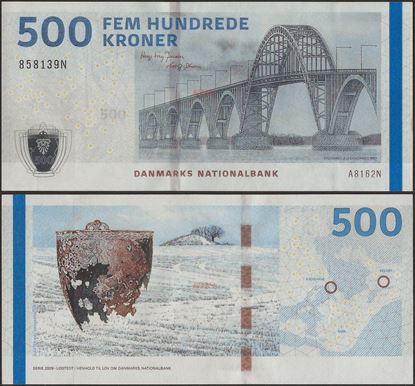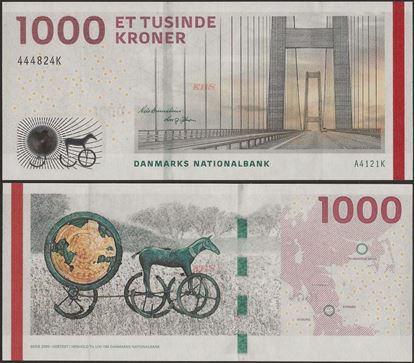
Denmark
1972 - 1998 Issues
These notes continue to bear the law date 7 April 1936 at lower right on back, below the series 1972 designation. However, as was the case with the preceding 5- and 10-krone notes, the issue date is encoded in the 6-character sequence number. The first letter and digit are the series, followed by two digits representing the last two digits of the year of issue.
On some notes, the solid security thread is black, while on others it is a light color and may be difficult to locate.
1997 - 2003 Issues
These new notes were introduced from 1997 to 1999.This so-called 1997 series was intended to keep up with advancements in new computer technology, making it more difficult for counterfeiters. All of the notes are the same height, though the width increases 10 millimeters with each higher denomination.
The main motif on the front of each note is a portrait at right of an individual who has made a significant contribution to Danish art or science. The designs on the backs are inspired by stone reliefs from Danish churches.
The letter in the latent image and holographic patch at upper left front represent the note’s denomination in Roman numerals (L = 50, C = 100, CC = 200, D = 500, M = 1,000)
2002 - 2008 Issues
These notes are like the preceding issues, but with holographic patches at upper left front and new fluorescent features visible under UV light.
2009 - 2016 Issue
These notes were designed by the artist Karin Birgitte Lund and have Danish bridges and prehistoric artifacts as their motifs (the circles on the back of each note indicate where the bridge is located and the artifact was found).
2019 (2020) Issue
These notes are like the preceding issues, but with new security threads, pearlescent stripes, and embossed geometric figures for sight-impaired users to distinguish between denominations. These new notes are printed by Oberthur Fiduciairie in France.
- Banknote Year
- 2011-2015
- 2016 - 2020











